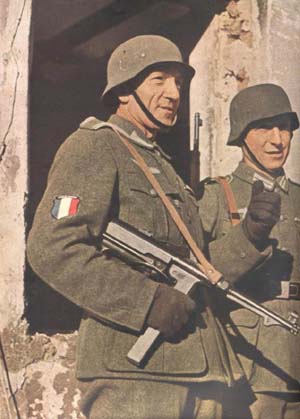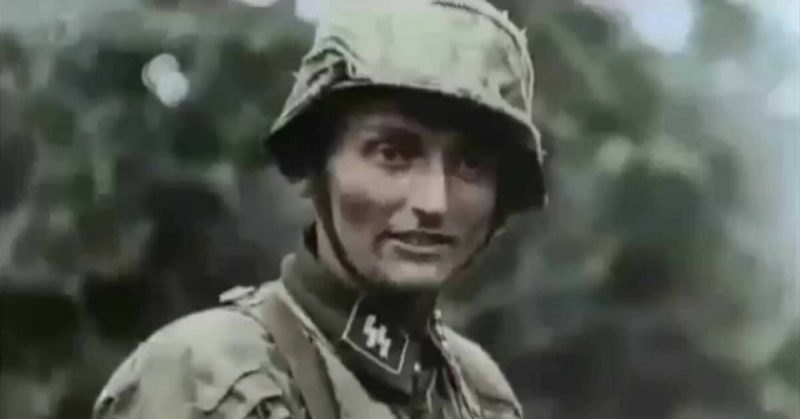The French volunteers of the Second World War constituted an entirely separate division in the Wehrmacht and after that the Waffen-SS which consisted of units that were called the 33rd Waffen Grenadier Division of the SS Charlemagne (1st French) and the Charlemagne Regiment.
With an impressive strength of an estimated 7,400-11,000 at its peak in 1944, the numbers came down to a mere sixty, as of May 1945.
Entrusted with the protection of Central Berlin as well as the Führer’s bunker from the Soviet invasion, they were one of the last remaining German units to have faced combat.
They were also among the last remaining to surrender; and as they knew very well that they could never survive if Germany got defeated, they continued to fight till the last days of the Battle of Berlin.
The unit’s crest represented the dual Charlemagne Empire that had united the Franks – a historical event that would contribute to the formation of France and Germany.
The crest equally represents France and Germany, with the fleur-de-lys on the right representing France (or West Francia, as it was called), and the Imperial Eagle on the left representing Germany.
The Charlemagne Unit and the Defence of Berlin
As of April 1945, Krukenberg was left with only 700 men under his command, who were segregated into a single heavy support battalion with no equipment and an infantry regiment consisting of two battalions (57 and 58).
While 400 of these were sent to serve in a construction battalion, the remaining 350 opted to go to Berlin to delay the coming of the Soviet forces.
On 23rd April 1945, Krukenberg was ordered by the Reich Chancellery of Berlin himself to lead his men to the capital. Reorganized as the “Sturmbattalion Charlemagne” (Assault Battalion Charlemagne), around 330 French troops, after taking a long detour to escape the Soviet forces reached Berlin on 24 April.

It was thereafter attached to the 11th SS Volunteer Panzergrenadier Division (also called “Nordland”), which greatly strengthened the division that had already lost its “Norge” and “Danmark” regiments in combat.
On 25 April, SS Brigadeführer Joachim Ziegler was relieved of his command of the Nordland Division, with SS-Brigadeführer Krukenberg simultaneously being appointed the commander of the (Berlin) Defence Sector C, which included the Nordland Division.
Much to their surprise, the soldiers noticed the unnatural quiet atmosphere of Berlin on their first night serving there, with no sounds of the fighting bar the distant sound of Soviet artillery. The soldiers proceeded to walk from West to East Berlin and reached a brewery near the Hermannplatz – which is where combat started, with the Hitler Youth firing Panzerfausts at the Soviet guards’ tanks that stood near the Tempelhof Aerodrome. The Sturmbattalion later joined them.
On 26 April, the Sturmbattalion participated in a counterattack in the Neukölln district in southeast Berlin. They joined forces with the Tiger II tanks and the 11th SS Panzer-Battalion “Hermann von Salza,” that ran into an ambush by Soviet troops using a captured German Panther tank.
This, in turn, led to half of the available troops being wiped out on the very first day. The remainder went on to defend Neukölln’s Town Hall.
With Neukölln completely invaded by Soviet forces, Krukenberg prepared fallback positions for Sector C defenders around Hermannplatz and shifted headquarters to the opera house.
With the Nordland Division’s withdrawal to Hermannplatz, the French SS and the Hitler Youth attached to their group destroyed 14 Soviet tanks using Panzerfausts, with one machine gun position by the Halensee Bridge being sufficient to hold up any Soviet advance in the area for the next 48 hours.

The Soviet invasion of Berlin consisted of massive shelling followed by assaults using battle groups consisting of around 80 men who were armed with tank escorts and artillery support. They managed to push back the remnants of Nordland Division to the central government district (Zitadelle sector) in Defence sector Z, with Krukenberg’s new Nordland headquarters being a carriage in the Stadtmitte U-Bahn station.
As of 28 April, about 108 Soviet tanks had been destroyed in south-east Berlin within the S-Bahn, 62 of which were destroyed by the Charlemagne Sturmbataillon alone, which went under the command of SS-Hauptsturmführer Henri Joseph Fenet, who was entrusted to defend Neukölln, Friedrichstrasse, Belle Alliance Platz, and Wilhelmstrasse.
A wounded Fenet with his battalion retreated to the Reich Aviation Ministry in the central government district led by SS-Brigadeführer Wilhelm Mohnke, who awarded Fenet the Knight’s Cross of the Iron Cross for the battalion’s victories in the Battle in Berlin.
With the Soviets now launching a full-scale attack into the central sector, the battle became more intense than ever and involved brutal combat.
The last defenders of Hitler’s bunker, the French Charlemagne units remained until 2 May and prevented the Soviets from conquering it on May Day.
The Sturmbattalion was reduced to a mere 30 in number, as most had either been captured or had escaped Berlin. Out of these, those who reached France were sentenced to camps and jails run by the Allied forces.
Fenet, for instance, was sentenced to 20 years in prison but was later released in 1959. Others, however, were shot upon capture by the French authorities.
